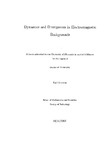Dynamics and Divergences in Electromagnetic Backgrounds
| dc.contributor.author | Jameson, Paul | |
| dc.contributor.other | Faculty of Science and Engineering | en_US |
| dc.date.accessioned | 2013-10-07T10:30:06Z | |
| dc.date.available | 2013-10-07T10:30:06Z | |
| dc.date.issued | 2007 | |
| dc.identifier | NOT AVAILABLE | en_US |
| dc.identifier.uri | http://hdl.handle.net/10026.1/2054 | |
| dc.description.abstract |
This thesis investigates the behaviour of a charge which is subjected to either an electromagnetic background created by a laser or a background which is hidden behind the resolution limitations of accelerator experiments. When a charge interacts with an intense laser beam its dynamics changes. The resulting trajectory of a non-relativistic particle is solved in this thesis without having to employ the dipole approximation. Many fundamental features of this trajectory are analysed including the drift velocity and the appearance of higher harmonic oscillations. In contrast, the interaction between a charge and an unobserved electromagnetic background leads to the infrared catastrophe. This has plagued field theories since the early nineteenth century. The standard theoretical response to such soft and collinear infrared divergences which are present in quantum field theories is the Lee-Nauenberg theorem. In this thesis a new class of collinear divergences associated with particles which are both soft and collinear will be discussed within the Coulomb scattering process. We show that all infrared singularities may be cancelled by the Lee- Nauenberg theorem but only if severe restrictions are placed on the normalisation of states and experimental set-up. | en_US |
| dc.language.iso | en | en_US |
| dc.publisher | University of Plymouth | en_US |
| dc.title | Dynamics and Divergences in Electromagnetic Backgrounds | en_US |
| dc.type | Thesis | |
| plymouth.version | Full version | en_US |
| dc.identifier.doi | http://dx.doi.org/10.24382/4349 |
Files in this item
This item appears in the following Collection(s)
-
01 Research Theses Main Collection
Research Theses Main


